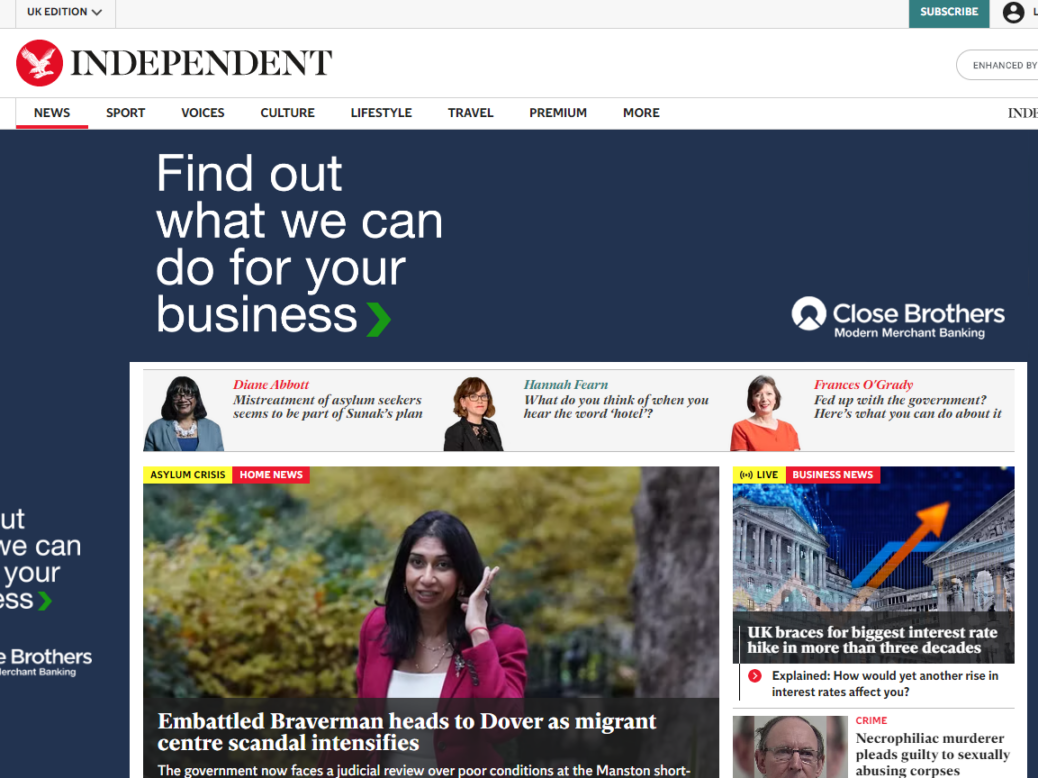
The Independent is considering cutting around a fifth of its staff despite seeing five years of consecutive profits and a record year in 2021.
It is also expected to announce a further year of record revenue in the financial year that closed at the end of September.
The outlet is joining an increasing number of publishers looking to get ahead of the recession by cutting costs amid a tricky time for the digital advertising market.
The Independent has put 52 roles at risk of redundancy, including 30 in editorial, as first reported by The Guardian and confirmed by Press Gazette.
A spokesperson for The Independent said: “Innovation and change have always been central to The Independent’s success, and this has led us to another year of above-market growth.
“However, considering the extraordinary economic headwinds that the entire industry is experiencing and the need to focus on our areas of growth, we have had to review the shape of our business, and undergo a consultation to close certain roles.
“Only by doing this can we keep our business strong, and fund independent, award-winning journalism for many years to come, holding our title as the UK’s most-read quality digital title.”
In 2021 The Independent had 244 staff members (its monthly average), up from 214 in 2020. In September 2021 the brand told Press Gazette it had 121 editorial staff in the UK while the US editorial team had 25 members with plans to double to 50 over the year.
Press Gazette analysis last month found 830 editorial job losses reported in 2022 so far, of which 89% came after June. In many of these cases employers have pointed to the “current global situation in relation to the conflict around Ukraine” and the aftermath of the Covid-19 pandemic.
The Independent has been hit by a market-wide decline in digital advertising and a change to Facebook’s algorithm earlier this year that deprioritised news in favour of content from users' family and friends.
This was one in a series of moves that appear to show the platform’s sidelining of publishers including the winding down of payments to publishers for Facebook News and of human curation of the tab as well as the end of Instant Articles and the rebranding of the News Feed to get rid of the “news” aspect.
Despite these difficulties, Press Gazette understands The Independent is continuing to see growth in the US, in e-commerce and at its video channel Independent TV which launched in 2020 and received more than 70 million views last month. Independent TV is also preparing to expand onto other channels with connected TV, and new TV and podcast studios are being opened at the title's office.
According to Similarweb data, 14% of The Independent’s traffic comes from social media and, of that, 30% comes from Facebook compared to 40% from Reddit and 26% from Twitter.
In September The Independent, which closed its print newspaper to go digital-only in 2016, was the UK’s sixth biggest newsbrand, according to industry-recognised Ipsos iris data, with an audience of 23.1 million and growth of 8% month-on-month. It reaches 46% of the UK adult population.
The Independent has been seeking to diversify its revenue sources in order to protect it from downturns like the market is facing at the moment. Around 60% of its revenue was derived from advertising last year, although it expected to decrease this to 47% in this fiscal year.
In 2021 Independent Digital News and Media saw revenue growth of 36%, which it put down both to a "buoyant" advertising market and an increase in reader revenue that came as it is increasingly pushing subscriptions and registrations in an effort to diversify and reduce its reliance on ads.
Its advertising revenue grew by £2.4m or 13% last year thanks to “the continued expansion of strategic advertising partnerships” through "custom content creation and TV capabilities," the company said in its accounts.
It said in those accounts it wanted to continue to “diversify income [to] reduce the exposure to advertising markets and ensure the sustainability of the brand”.
The Independent has been in profit every year since it went digital-only, making £3.3m in its first full-year and a record £5.5m in operating profit in 2021.
But even the tech giants that dominate the digital advertising market are struggling at the moment.
Google-owned Youtube reported its first-ever advertising revenue decline last month, Facebook parent Meta reported its second consecutive advertising drop, and Snapchat owner Snap said it was "finding that our advertising partners across many industries are decreasing their marketing budgets, especially in the face of operating environment headwinds, inflation-driven cost pressures, and rising costs of capital".
Meanwhile new Twitter owner Elon Musk, who has just bought a platform that is currently 90% reliant on advertising, said on Monday: "We need to pay the bills somehow! Twitter cannot rely entirely on advertisers."
However last week the Advertising Association and WARC, which together produce a quarterly ad expenditure report, anticipated year-on-year online national newsbrand adspend growth of 8% and overall online display growth of 7%.
Known job cuts across the UK, US and Ireland media industry so far this year:
Email pged@pressgazette.co.uk to point out mistakes, provide story tips or send in a letter for publication on our "Letters Page" blog
